There are 23 woodpecker species in North America, but only seven species are migrators. In this article, I’ll reveal those seven woodpecker species that migrate as well as the ones that don’t.
For each migrating woodpecker, I included photos and descriptions to help you identify them, diet and habitat information so you can tell if you’re surrounded by an area they might live, feeder food they love so you can entice them to your yard, and details of their migration behavior so you know when they’re expected to be where. Lastly, you’ll find range maps illustrating their exact locations so you know which ones to keep an eye out for.
Why Woodpeckers Migrate
Like many other wild birds, some woodpecker species migrate twice a year. According to World Migratory Bird Day, the reason birds migrate is “to find the best ecological conditions and habitats for feeding, breeding, and raising their young”.
Scientists believe birds may also migrate due to genetic predisposition or a genetically driven urge to migrate.
Migrating woodpeckers are considered short-distance migrators which means they may travel hundreds of miles but they do not cover thousands of miles across multiple countries or continents like long-distance migrants do.
Birds migrate to find the best ecological conditions and habitats for feeding, breeding, and raising their young.
World Migratory Bird Day
Woodpeckers that Migrate
The seven woodpecker species that migrate are listed below followed by photos, descriptions, diet, feeder food, habitat, and detailed migration information.
By the way, sapsuckers and flickers are part of the woodpecker family.
- Lewis’s Woodpecker
- Northern Flicker
- Red-Breasted Sapsucker
- Red-Headed Woodpecker
- Red-Naped Sapsucker
- Williamson’s Sapsucker
- Yellow-Bellied Sapsucker
1. Lewis’s Woodpecker
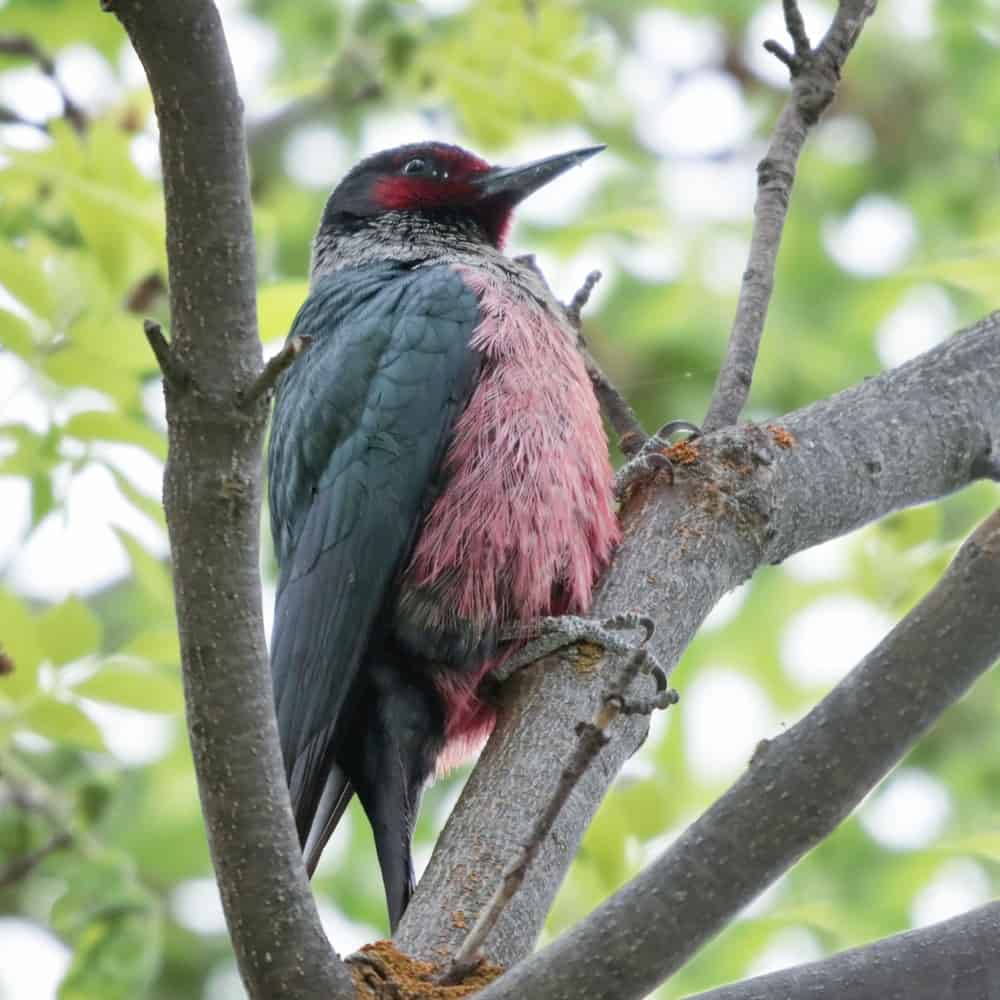
Appearance: The Lewis’s woodpecker is about 10-11″ long, dark iridescent green, a silver collar, black head and pointy bill, deep red on their face, red or salmon on the lower breast and belly. Male and females look the same, males are typically a bit larger.
Diet: Adult insects (especially ants, bees, wasps, butterflies, beetles & grasshoppers), nuts (acorns, almonds), fruit (apples, cherries, peaches, wild berries), and seeds. In winter they’ll commonly collect acorns, almonds, and corn then store them in tree cavities, crevices, etc. for later consumption.
Feeder food: Shelled peanuts, suet, sunflower seeds.
Habitat: During the breeding season, Lewis’s woodpeckers are found in open areas filled with pines, junipers, and oak trees as well as orchards and agricultural areas. They have a strong preference for ponderosa pines and forested areas. They’re particularly attracted to burn areas as the allure of dead trees is too enticing to resist.
Year-round range: Oregon, California, Utah, Colorado, Arizona, and New Mexico
Breeding range: British Columbia, Washington, Oregon, Nevada, Idaho, Montana, Wyoming, Utah, Colorado.
Migration: Lewis’s woodpeckers do migrate. In the spring, some migrate north for breeding while others remain in their year-round range to reproduce. In the fall and winter, few of them remain in the breeding range during winter, others will hang out in family groups wandering throughout their year-round range in search of food. Most will head south for the winter spending time inland California – especially in valleys and lower mountain elevations.
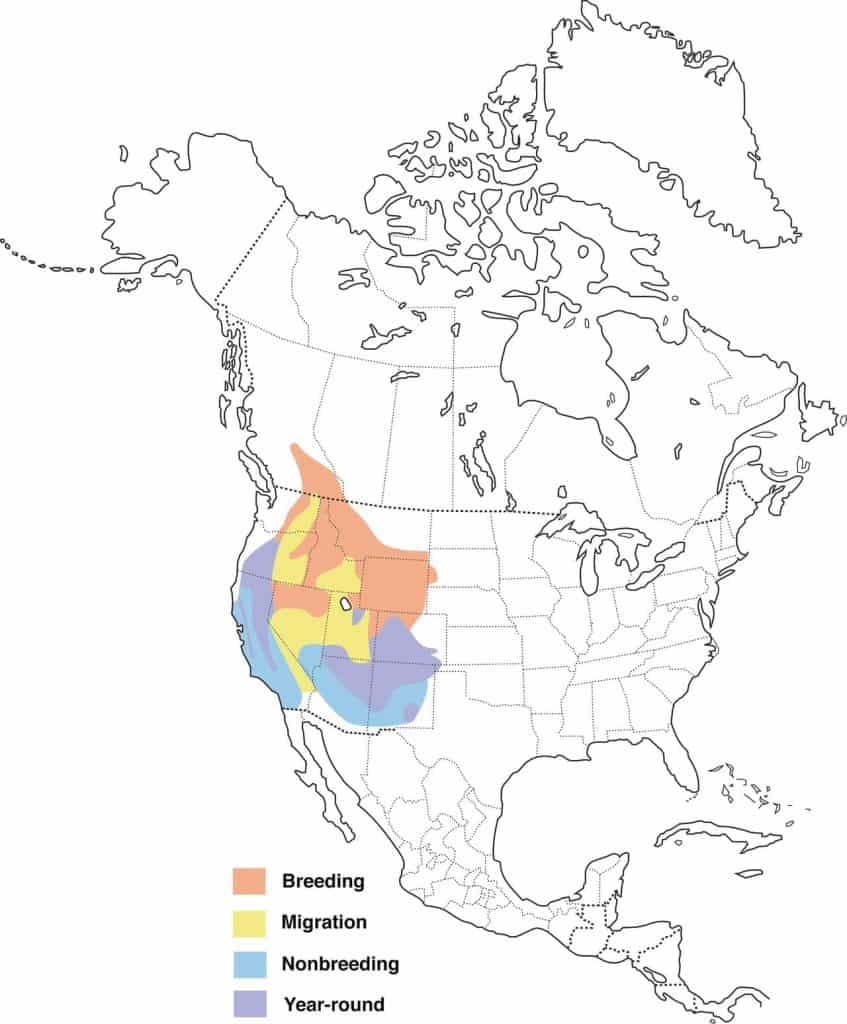
2. Northern Flicker
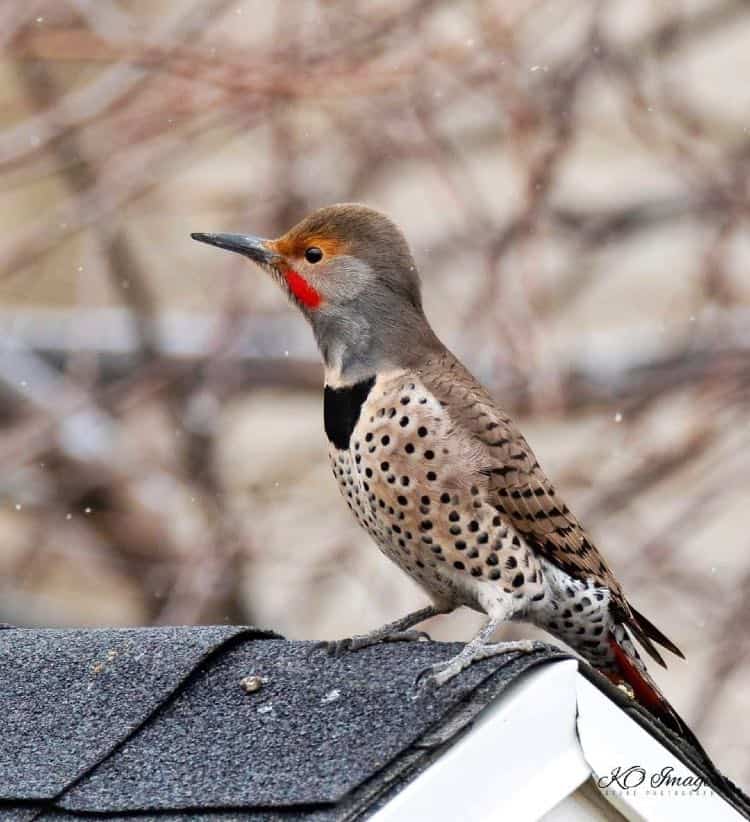
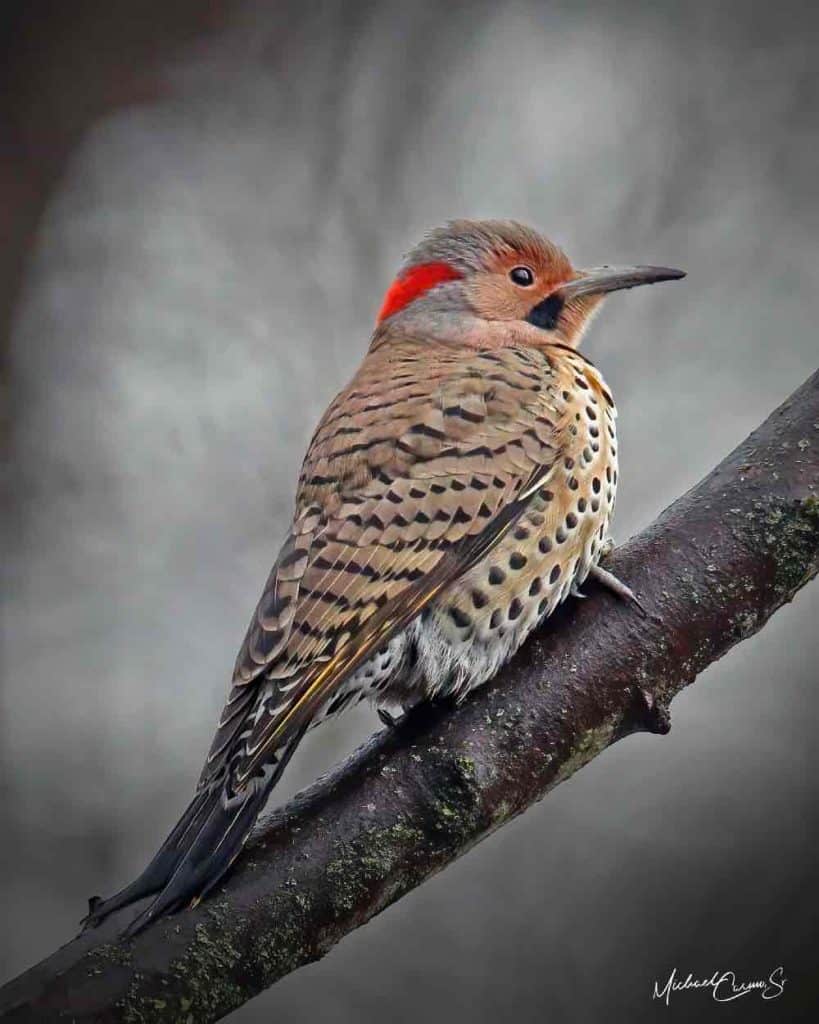
Appearance: A large bird about 12.5″ long. They have brown backs with black bars, a black crescent on the upper chest, and white with black spots on the belly and underparts.
• In the eastern part of their range, they are referred to as “yellow-shafted northern flickers” and have bright yellow underwings and undertail. They have a gray crown, tan face, and a red patch on the nape. The male has a black swipe on his cheek, the female does not.
• In the western part of their range, they are referred to as “red-shafted northern flickers” and have pink underwings and undertail, brown crown, gray face, and crown & nape are brown. The male has a red swipe on his cheek, the female does not
Diet: Insects, especially ants.
Feeder food: Hulled peanuts and suet.
Habitat: Open areas near trees.
Migration: Northern flickers are migrators. Scientists believe the timing and duration of their migration from the breeding range to their winter range are dependent on weather. They generally migrate at night, and travel in large but loose flocks of up to 100 or so birds.
Year-round range: Each US state as well as parts of British Columbia,
Breeding range: Alaska, Canada, and inland parts of their year-round range in Washington, Oregon, and California.
Winter range: Many will winter in the year-round range while others head further south into southeast California, southwest Arizona, Texas, and Mexico.
Range Map
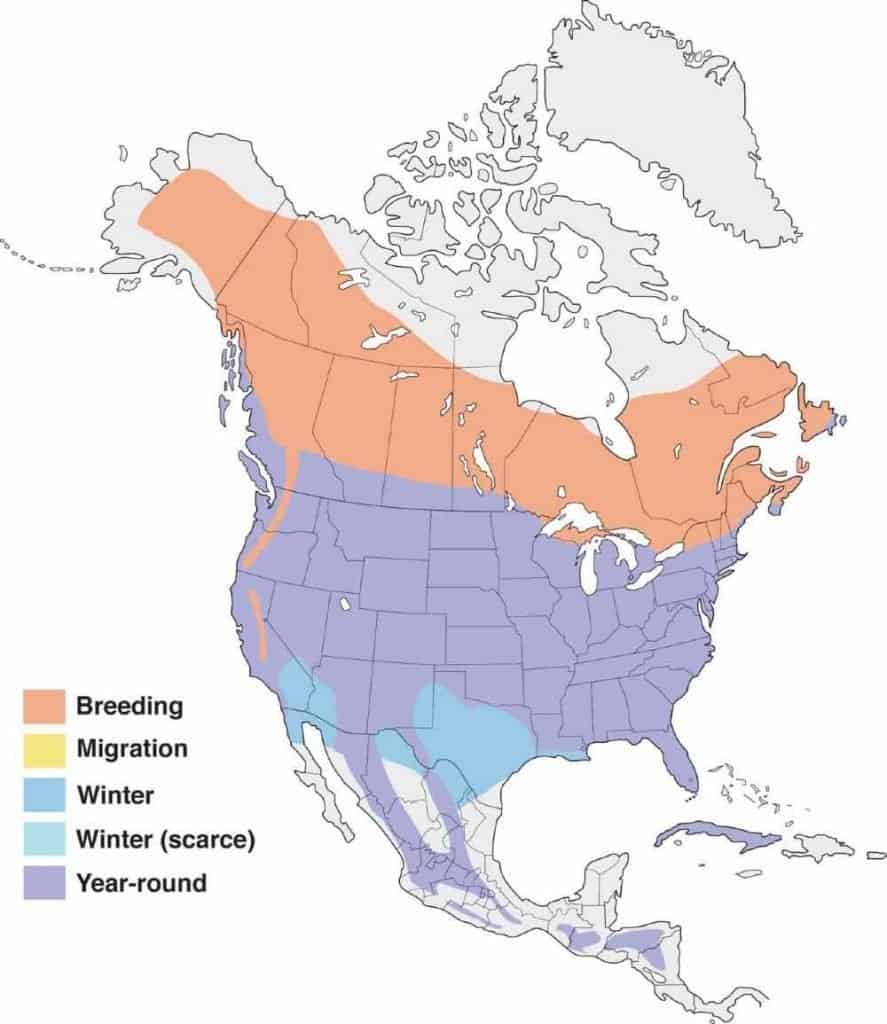
3. Red-Headed Woodpecker
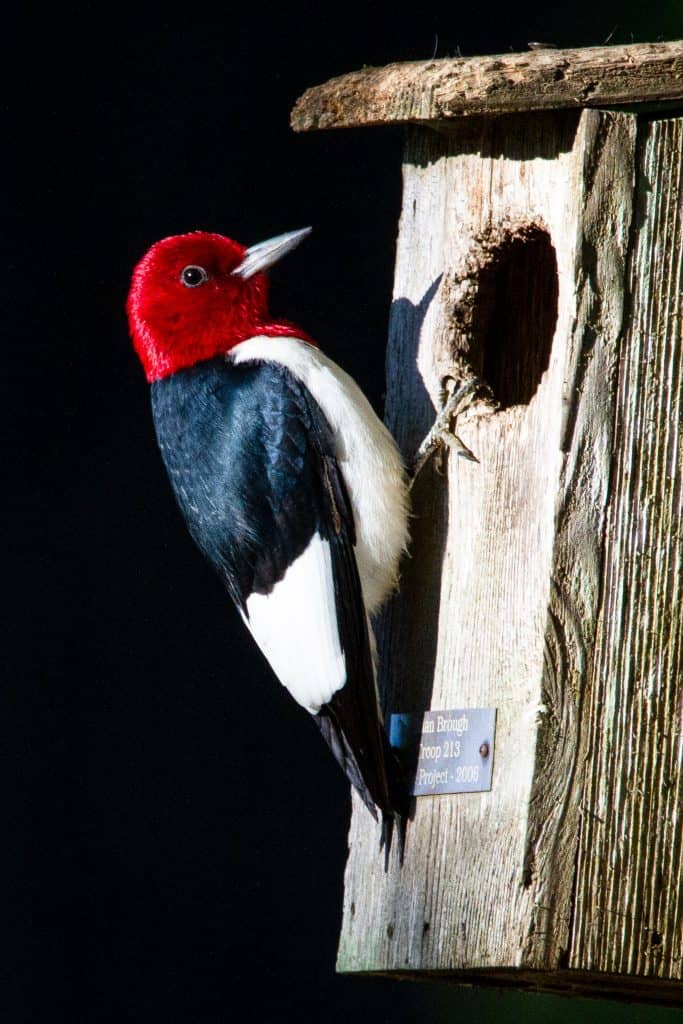
Appearance: Red-headed woodpeckers are medium-sized birds about 9″ long with a red head, black back, white rump, chest, and belly. Also has white patches on its wings, black tail, and gray legs and bill. The female is the same as the male.
Diet: Insects, fruit, nuts, and seeds.
Feeder food: Suet and hulled peanuts.
Habitat: During the breeding season, they prefer open woodlands especially when ample deciduous trees are present, as well as short-grass meadows, pastures, or even golf courses. In the winter they can be found in tall grass prairies with plenty of oak trees and anywhere a mass of acorn crops are present.
Migration: Some, but not all, red-headed woodpeckers are migrators. In spring they’ll remain in their year-round range for breeding or head west and north into Canada to reproduce. In fall, especially when the supply of acorns wains, they’ll migrate south back to their year-round range and if crops are really poor, southwest into Texas.
Year-round range: From Oklahoma and eastern Kansas east to Pennsylvania and Maryland, and south throughout the southeast United States.
Breeding range: Some red-headed woodpeckers breed in the year-round range (see above) while others head west and north – as far north as southern portions of Saskatchewan and Manitoba, Canada, and as far west as central Montana. Few reach the southeastern portion of Quebec.
Winter range: Most red-headed woodpeckers winter in their year-round range while a few heads further southwest into central Texas and southern Louisiana. The winter movement is highly dependent on acorn supplies. When in abundance, red-headed woodpeckers may not migrate from their year-round range at all.
Range Map
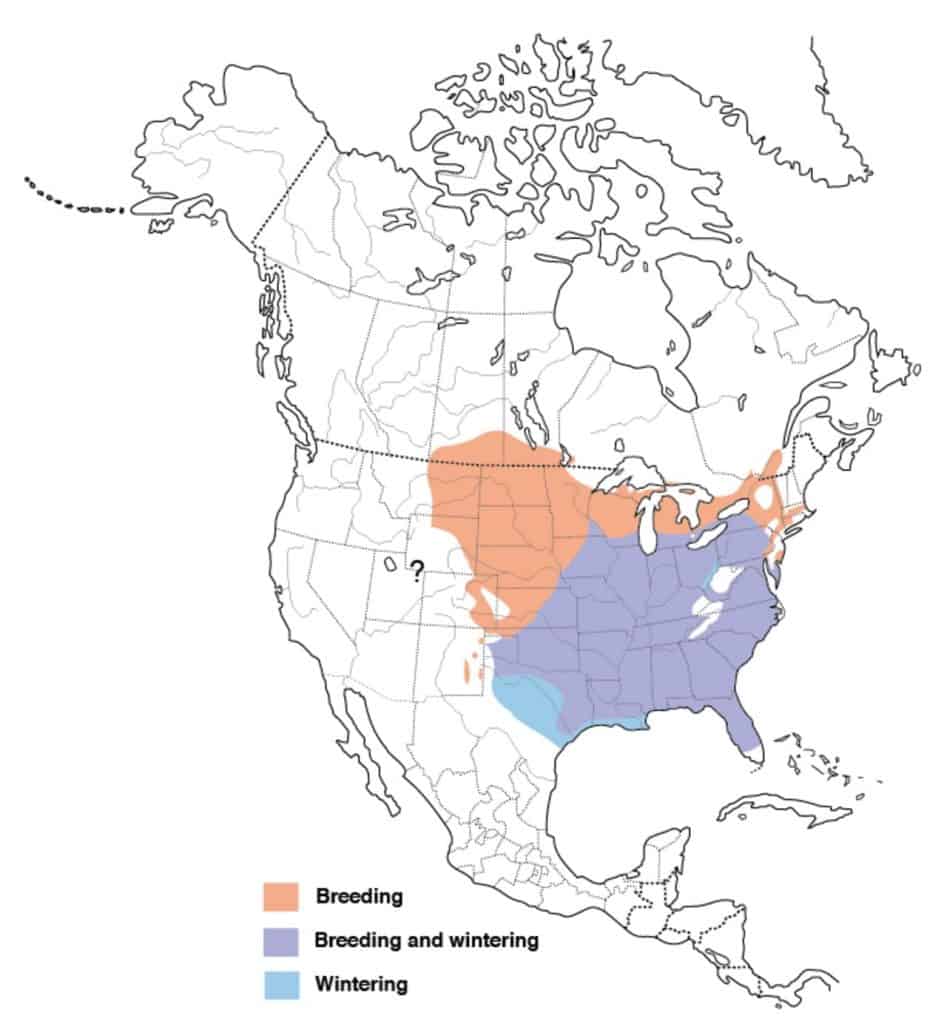
4. Red-Breasted Sapsucker
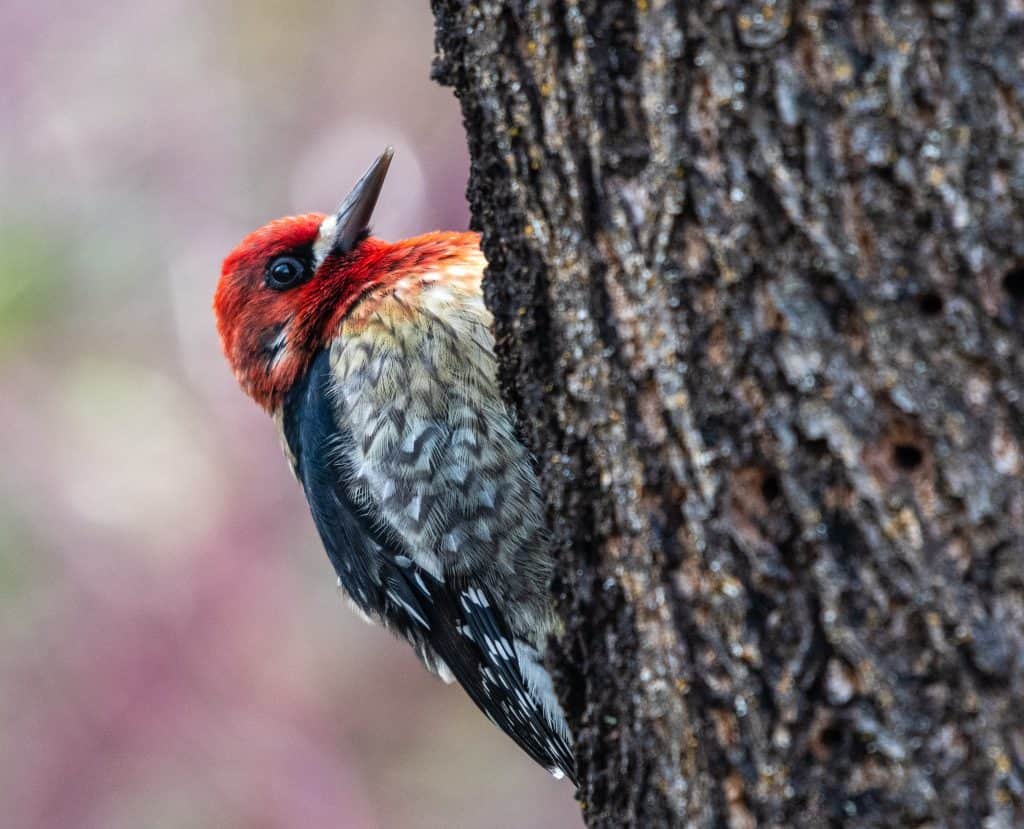
Appearance: The red-breasted sapsucker is a medium-sized woodpecker about 8-9″ long. They have a red head with black on either side of their face from the base of the bill to the front of the eyes (area referred to as lores), and white tuffs of feathers at the base of the bill. The upper back is black with two narrow stripes and buff-colored spots. Wings are black with white underwings, belly is yellow in center. Females are similar. Juveniles have dark brown or olive-colored heads instead of red, sides are charcoal, and the center of the belly is a faint yellow. dark brown or olive
Diet: Tree sap, cambium (cell layer beneath the tree bark), insects, and small fruits.
Feeder Food: Suet.
Habitat: During the breeding season they can be found in mixed conifer forests, especially when mixed with aspens, or in open areas with Douglas firs and spruce trees.
Migration: Some, but not all, red-breasted sapsuckers are migrators. Many remain in their year-round range for all seasons of the year. In spring, the northern migrators leave the year-round range and head north to inland British Columbia while those in the southern part of the year-round range head a bit east into inland California. Then in fall, those that breed in the north migrate west to the coast of British Columbia, south to the coast of California, inland California, or western Nevada for the winter.
Year-round range: Along the pacific coast from British Columbia, Canada, Washington, Oregon, northern California as well, and inland southern California.
Breeding range: Inland in Canada’s British Columbia as well as Washington and California.
Winter range: While many red-breasted sapsuckers remain in their year-round range all seasons of the year, some head south throughout California, northwestern Nevada, and a bit into Mexico.
Range Map
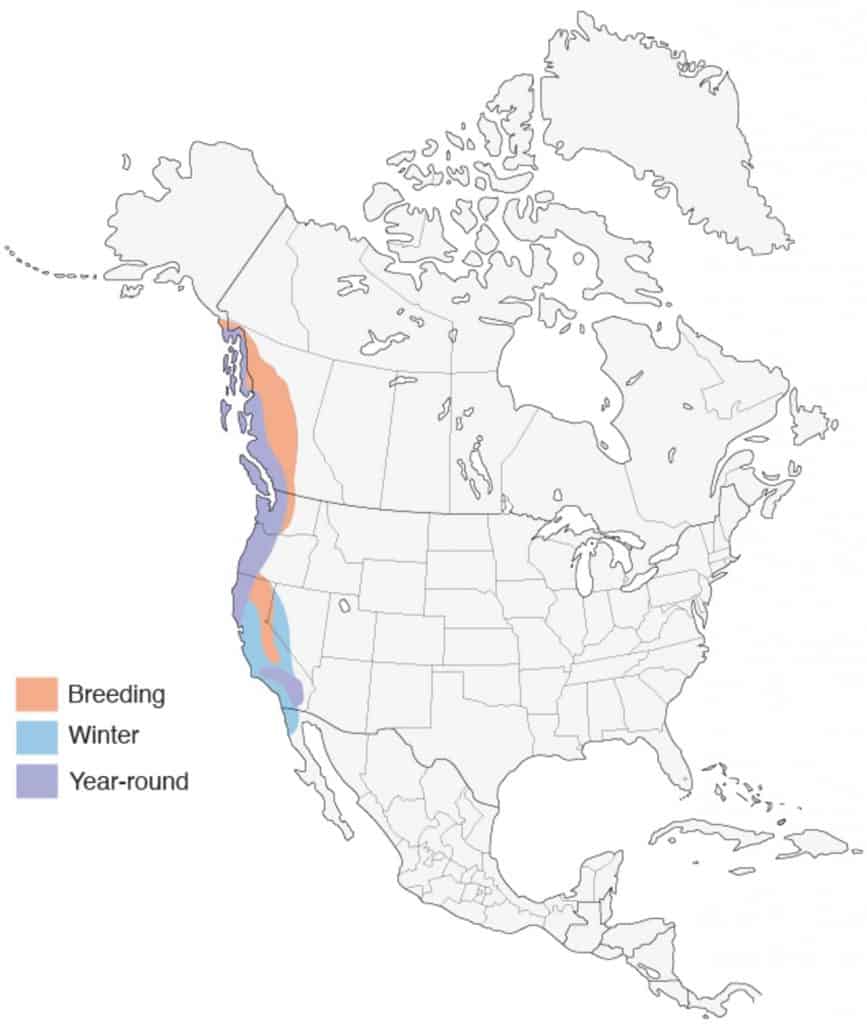
5. Red-Naped Sapsucker
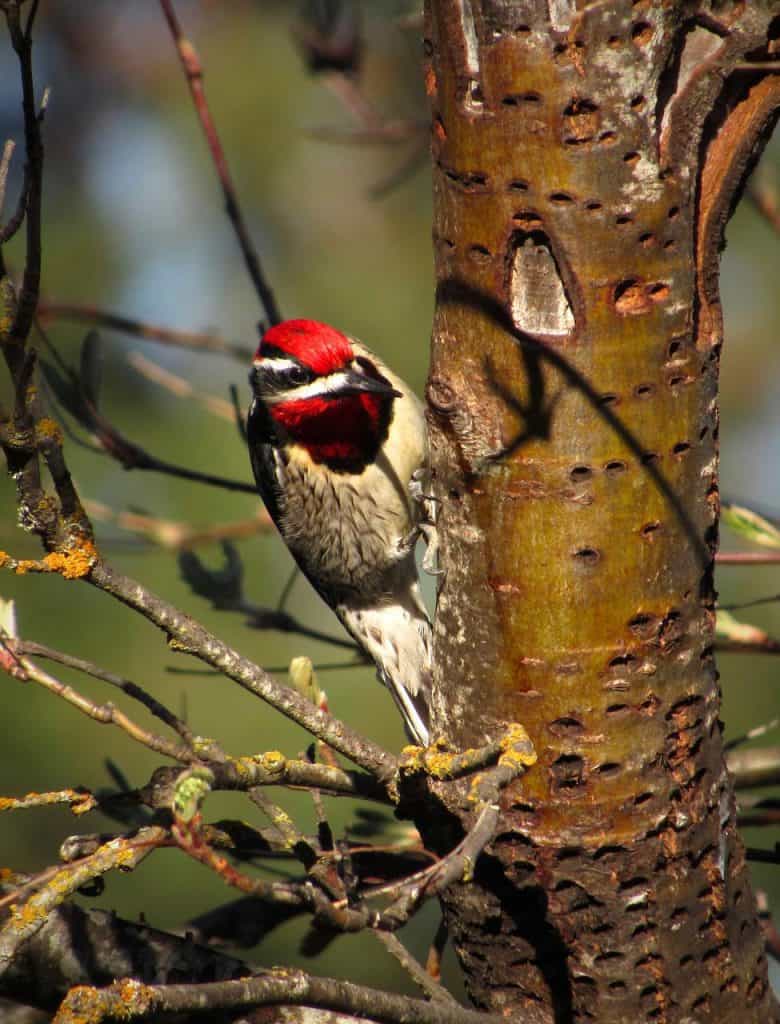
Appearance: Red-naped Sapsuckers’ heads are striped with black, white and bright red. Bright red also encompasses their cap, throat and back of the neck. The belly is spotted black and white, with a dark yellow color. Females are the same except they have a white patch on their chin – males’ chins are red. Juveniles have a brown cap and a brown color on their belly and head.
Diet: Tree sap, arthropods (ants, caterpillars, mayflies, beetles, mothers), fruits, berries, and seeds.
Feeder food: Suet.
Habitat: Mixed forests of deciduous and coniferous trees, orchards, and wooded areas by streams.
Year-round range: Eastern California, southcentral Nevada, western Utah, Arizona, and New Mexico.
Breeding range: Their breeding range includes the Canadian provinces of British Columbia (southeastern) and Alberta (southern), as well as eastern Washington, northeast Oregon, Idaho (except southwestern), the western halves of Montana, Wyoming, & Colorado, and northern New Mexico, northeast California, northern Nevada, Utah, and northern New Mexico.
Winter range: Their year-round range plus southern California, Mexico, southern Arizona, southern New Mexico, and western Texas.
Migration: Red-naped sapsuckers are short-range migrators. While a small population of this species remains in the year-round range all seasons, most migrate north into southern Canada for breeding, and as far south as Mexico for winter.
Range Map:
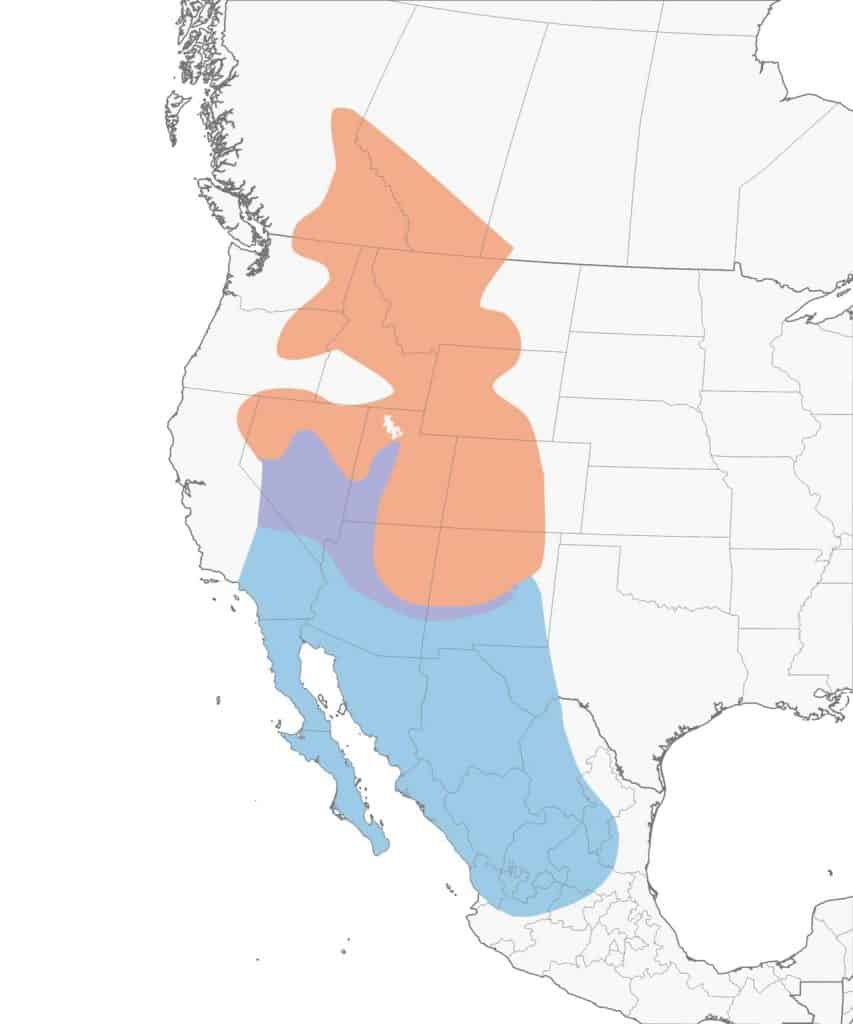
Red-naped sapsucker range map. Compliments of The Cornell Lab.
6. Williamson’s Sapsucker
Appearance: Williamson’s Sapsucker is a medium-sized woodpecker with a smooth black body, a bright-red throat, a bright yellow belly, and white wing patches. The female looks very different. She has a brown head, black and white bands across her back, and small bits of black and yellow on her belly.
Diet: Tree sap, insects, fruit, and seeds.
Feeder food: Unlikely to visit a feeder.
Habitat: During the breeding season, Williamson’s sapsuckers prefer mature forests with mixed conifer and aspen trees. When fall and winter roll around, their preference turns to forests with a mix of oak, juniper, and pine trees.
Year-round range: Small central strips of Oregon, California, Arizona, and New Mexico.
Breeding range:
Winter range: Southeast Arizona, southern California, southwest New Mexico, and the central strip of Mexico.
Migration: Williamson’s sapsuckers are migrators, however, scientists find their pattern to be a bit of a mystery – especially outside of the breeding season. Some are known to remain in their year-round range (patchy areas of Oregon, California, Arizona, and New Mexico) for all seasons, most of them migrate northward to spotty areas for breeding, and in fall, head south of their year-round range (into Mexico) for winter.
Range Map
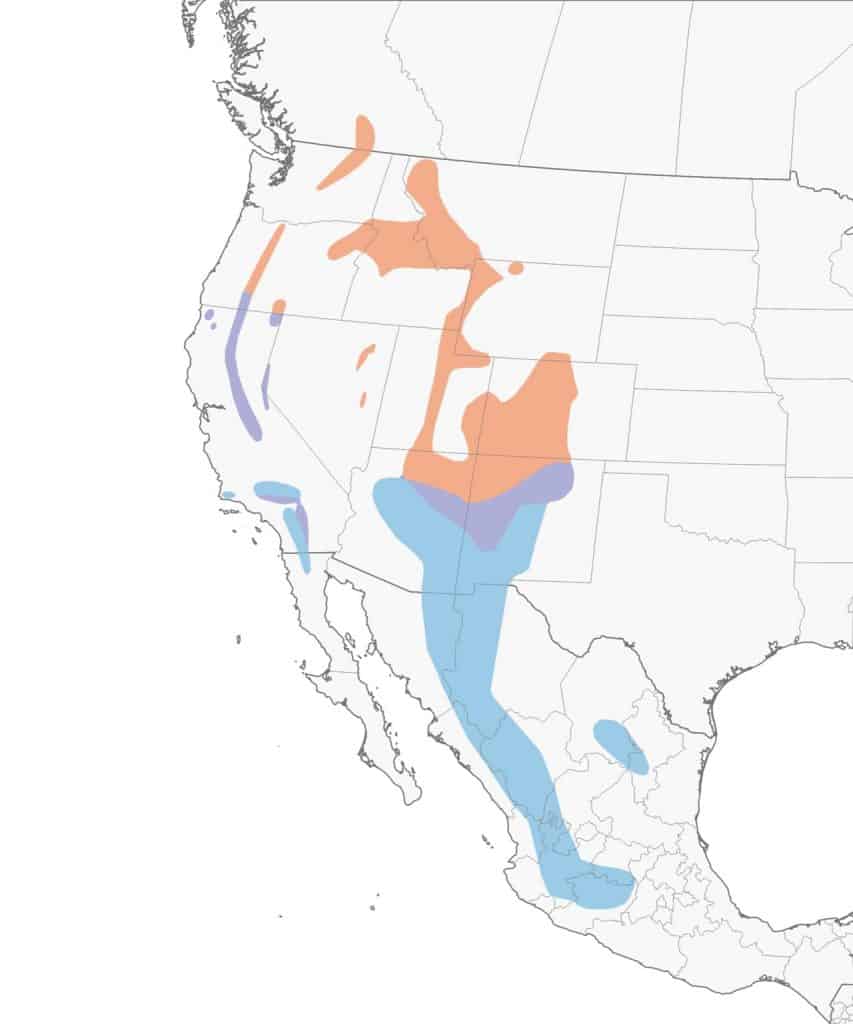
7. Yellow-Bellied Sapsucker
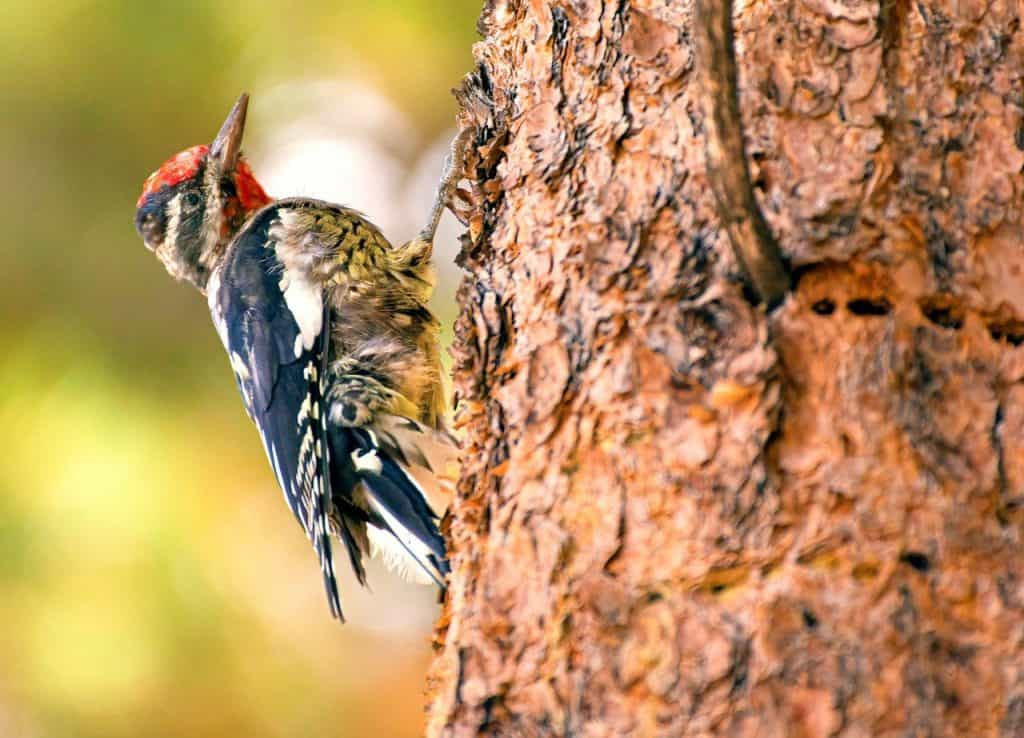
Appearance: Small bird about 8-9″ long with a checkered back. They have a red forehead, crown, and chin. The chest and belly are tan to yellow and have white wing patches. The Female is similar except she has a white marking on her chin.
Diet: Berries and fruit, bast (inner bark of a tree), few insects.
Feeder food: Suet.
Habitat: They prefer densely wooded areas with living trees (most woodpeckers prefer dead trees).
Migration
Right around mid-September through October, yellow-bellied sapsuckers migrate south for the winter and spend the season in Nebraska, Missouri, Illinois, Indiana, Ohio, Arkansas, Oklahoma, Texas, Louisiana, Mississippi, Alabama, Georgia, Florida, North Carolina, South Carolina, Virginia, Maryland, Delaware, and New Jersey.
Then around the April-early May timeframe, they begin their migration north in search of ideal nesting conditions.
Range Map
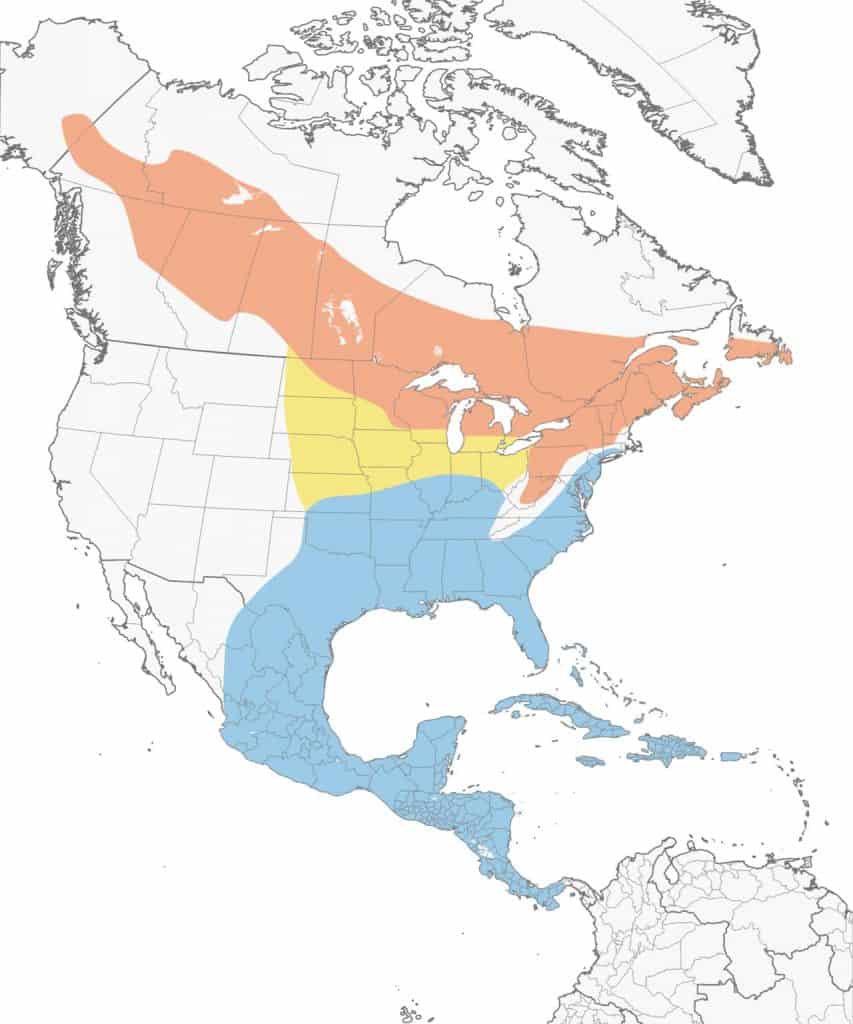
Woodpeckers that Don’t Migrate
We explored the seven woodpecker species that are migrators. Now it’s time to know the 16 North American woodpeckers that do not migrate. They remain in their year-round range all seasons of the year or if they do move, it’s a very short distance such as a few miles.
- Acorn Woodpecker
- American Three-toed Woodpecker
- Arizona Woodpecker
- Black-Backed Woodpecker
- Downy Woodpecker
- Gila Woodpecker
- Gilded Flicker
- Golden-Fronted Woodpecker
- Hairy Woodpecker
- Ivory-Billed Woodpecker
- Ladder-Backed Woodpecker
- Nuttall’s Woodpecker
- Pileated Woodpecker
- Red-Bellied Woodpecker
- Red-Cockaded Woodpecker
- White-Headed Woodpecker
In Conclusion
North American woodpeckers are an interesting bunch. Some are called woodpeckers, some sapsuckers, and others flickers – but they’re all part of the same family.
Most woodpeckers don’t migrate but seven species do. They include Lewis’s woodpecker, the northern flicker, the red-breasted sapsucker, the red-headed woodpecker, the red-naped sapsucker, Williamson’s sapsucker, and the yellow-bellied sapsucker.
Among the seven migrators, all but one have a year-round range in which many of the population remains for all four seasons, yet some of them migrate for spring and fall.
What an amazing family of birds we have in North America to enjoy. As widespread as woodpeckers are we should all be able to enjoy in our neck of the woods. If not year-round, then perhaps when they’re visiting for a season or just passing through.
Hope you enjoyed. Happy birding!


